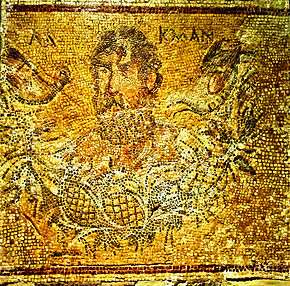Jordanian wine

Jordan's long history implies that wine was produced there in ancient times,[1] as far back as Nabatean times.[2] Several sources suggest that the wine served to Jesus during the Last Supper came from Umm Qais in Northern Jordan.[3] Although Israeli and Lebanese wines dominate the wine industry in the region, some Jordanian wineries are producing organic wines, which made them popular.[4] The Wine Institute (USA) estimates Jordan's wine production at approximately 500,000 litres per year.[5] Nominal per-capita consumption is 0.1 litres, but the figure is potentially misleading as little of the wine is drunk by Jordanian citizens.[4] Quality has improved from unremarkable in the 1980s to very acceptable by 2009.[6]
Based on historical evidence in Jordan, wine making was popular back in 30 BC. This legacy was revived in 1953 when Mudieb M. Haddad founded Eagle Distilleries Company. In 1975 Italian experts collaborated with the Haddad Family to build the first “state of the art” winery in Jordan. In the year 2000 the winery was transformed to modern wine-making and in 2004 over 40 world-renowned grape varieties were planted in the Haddad Estates. The vineyards are located in the Mafraq plateau area nearby the dormant volcanic mountain of Jabal Al-Arab; which lies 1,800 meters above sea level. The water from rain and melting snow flows from the mountain under the Basalt Desert and accumulates in aquifers 400 meters below the surface which is used in Dry Farming the thriving vines in rich virgin mineral volcanic soil.
Grape varieties
The traditional local grape varieties appear to have been lost. Jordanian wines are therefore of necessity made from imported varieties of Vitis vinifera. Red wines are made using Cabernet Sauvignon, Merlot, Shiraz and Pinot noir. White wines are made using Chardonnay, Muscat, Pinot gris, Gewürztraminer and Chenin blanc.[7]
In 2013, Carmenère grapes of Chilean origin, and Tokai grapes from Italy, were being grown at Omar Zumot's vineyard in Northern Jordan.[8] Zumot's award-winning wines are labelled "Saint George" and "Machaerus".[9] The Haddad winery makes white wines labelled "Mount Nebo" and both red and white wines labelled "Jordan River".[9]
See also
References
- ↑ "Jordan Wine". wine-searcher.com. Retrieved 2015-11-25.
- ↑ http://www.jordantimes.com/news/local/archaeologist-highlights-nabataean-heritage-agriculture-wine-making
- ↑ "Experiences- Wines of the Holy land - Jordan". panacheworld.com. Retrieved 25 November 2015.
- 1 2 Teller, Matthew. "A Vine Romance". CNN Traveller, republished on BeAmman.com. Archived from the original on 2015-11-26. Retrieved 2015-11-25.
- ↑ "Natural Agriculture in Jordan produces a distinctive wine". Amman Net. Retrieved 29 December 2015.
- ↑ Wayne R. Schreiner (2009). From Kansas to Kenya: an Uncommon Road for Wine Lovers: A Memoir and Guide to the Simple Enjoyment of Wine. iUniverse. pp. 457–458. ISBN 978-1-4401-6199-5.
- ↑ "Jordanian Wine". wine-searcher.com. Retrieved 29 December 2015.
- ↑ Rastegar, Natasha. "Jordan: An unlikely winery visit". Wine Intelligence.com. Retrieved 29 December 2015.
- 1 2 "Jordan: Food and Drink". Rough Guides. 2015. Retrieved 29 December 2015.